The Financial Health Index: Which U.S. Cities are Flourishing?
Key Takeaways
- Examine how U.S. cities with over 1 million residents are handling financial health amid the challenges brought by the COVID-19 pandemic
- Indianapolis ranks as the financially healthiest city, boasting a strong emergency fund, favorable business tax climate, and high home affordability. Other top cities include Salt Lake City and Atlanta, noted for their robust business environments and municipal financial health
- The study considers 11 factors across three categories: metro financial health, business financial health, and resident financial health
- Learn about the importance of a balanced approach to municipal, business, and residential financial health for a city's overall economic well-being

Global pandemics have a way of turning traditional economic patterns on their heads. In the case of COVID-19, the upheaval first came in the form of lockdowns that added 8.8 million people to the unemployment rolls. With operations halted, supply chain bottlenecks followed.
Later, as hundreds of millions of dollars in federal COVID relief funds flooded cities, strides in affordable housing, clean energy, and resident services stabilized city economies and battle-scarred residents.
Now, as concerns about inflation rage, the pressure is on again.
Some U.S. cities and their residents are bearing the downturn better than others.
Here at The Credit Review, we wanted to uncover which U.S. metros with over 1 million residents have the best toolkits to emerge with their financial health intact, even in an unpredictable national environment. We looked at 11 total factors across three broad economic categories: metro financial health, business financial health, and resident financial health, to find out which fiscally smart cities are on course to thrive no matter what the future brings.
Big Takeaways:
- Indianapolis is the financially healthiest city in the nation. It has a 55-day emergency fund, a top-ten tax climate for businesses, and the highest home affordability of any city in our top ten, with an average home value of $273,896. It’s followed by #2 Salt Lake City and #3 Atlanta.
- The Beehive State mentality has been good for business in Salt Lake City. Companies looking for a buzzy, industrious home base should seek out Salt Lake City. The city gets perfect marks for business viability thanks to its high business creation score, an incredibly low number of business bankruptcies (3rd overall in our study, with a total of 11), and a top business tax climate.
- Atlanta is city-savvy. The Atlanta Metropolitan area scored highest by municipal financial health factors. Its emergency reserves could carry the state for over 2 months, and its income-to-debt ratio is a healthy 1.64.
- It’s a new “Gusher Age” for Houston’s residents. It’s not oil that’s transforming Texas anymore. However, Houston’s residents are still thriving thanks to low household debt, affordable homes, and a home-building boom — more than one new construction home was built last year for every 100 people in the area.
The Best Cities for Municipal, Business, and Residential Financial Health in 2023
The intertwined health of cities, businesses, and residents are all significant in taking a city’s financial temperature.
When a city’s businesses create more jobs, residents can pay their expenses and contribute to its coffers. That benefits cities, which spend less on services for needy residents and reap a stable income in property taxes.
So we took these three categories into account, looking at the following factors in each category:
- Municipal Financial Health
- The per-capita GDP for the metropolitan statistical area
- The rainy day score: How many days could the state continue providing services without new revenue?
- The state’s ratio of revenue to debt
- Business Financial Health
- New business creation: A ratio of businesses moving in versus exits
- The per capita rate of new business applications
- Job creation: New business starts elevate the financial health of cities better when they create more jobs
- The number of MSA business bankruptcies
- How friendly the state business tax climate is for companies
- Resident Financial Health
- Average household income, regardless of the cost of living
- Home affordability: How much does housing cost compared to the average household income?
- The number of per capita new housing construction permits awarded
- Whether residents maintain a low household debt-to-income ratio living in this city
Municipal Financial Health
Atlanta didn’t take the top prize in any subcategories but won the municipal top spot thanks to its high rainy day reserves. With 66.4 days of emergency funds, this Georgia peach is less than 3 days short of the number-one spot in the nation (that honor belongs to Las Vegas). The state also keeps debt low and revenue high, finishing just out of the top ten in that category and behind other all-around winners Charlotte, Raleigh,and Salt Lake City.
Some cities stood out in this category because they had sky-high scores in one area, like San Jose’s per capita GDP of $184,671 (that’s more than $50,000 above #2 San Francisco and more than $140,000 more than last-place Riverside). Yet high incomes in Silicon Valley come with correspondingly high expenses, diminishing the city’s fiscal advantage.
Business Financial Health
For businesses with staying power, look to Salt Lake City, which benefits from Utah’s pioneering tax climate, 8th-best in the nation. Hardworking Valley residents are also some of the best in the nation when it comes to keeping those profits rolling in — the city’s got one of the lowest bankruptcy rates, with just Tucson, AZ, and Rochester, NY, registering fewer business bankruptcies. Salt Lake City also ranks 12th in the nation for New Business Creation (with a favorable ratio of births to exits of 1.11).
But if you’re an entrepreneur, you might want to hit the beach instead of the slopes. Miami is top registering new businesses per capita, with 4.4 out of every 100 people carving out their own little piece of the career pie on its sandy shores (also in the top ten are neighbors Orlando, Tampa, and Jacksonville). Business must be booming in The Sunshine State because all four also make the top 20 cities for job creation (Jacksonville takes the top spot here).
Curiously, Florida’s category dominance didn’t mean a place for any of its cities in the overall top ten. In municipal health, Miami is the only Florida city that breaks into the top half of U.S. cities. While not one of Florida’s cities are in the nation's top half for residential financial health.
Resident Financial Health
With its stratospheric household incomes, San Jose peeks into the top ten, coming in 9th in a field where it’s an obvious outlier. For the most part, the top cities in residential financial health boast low costs of living, like #1 Houston, where the average household income is less than half of San Jose’s, but the average house costs about a fifth of what Silicon Valley residents have to fork over for a place to call their own.
Other Texas cities score well in this category, too. Dallas and Austin also make the top ten. Both have high home-building scores (Austin comes in 1st while Dallas is 9th), and Dallas is a top contender for keeping its residents’ debt-to-income ratio low (it comes in 4th overall, just behind Houston).
Top 10 Cities by The Triad of Financial Factors
While some cities specialize in business prowess or a favorable tax climate, a mix of municipal, business, and residential financial health makes the city’s overall ecosystem healthiest.
Who did best overall? Let’s break down the top ten.
#1 Indianapolis-Carmel-Anderson, IN
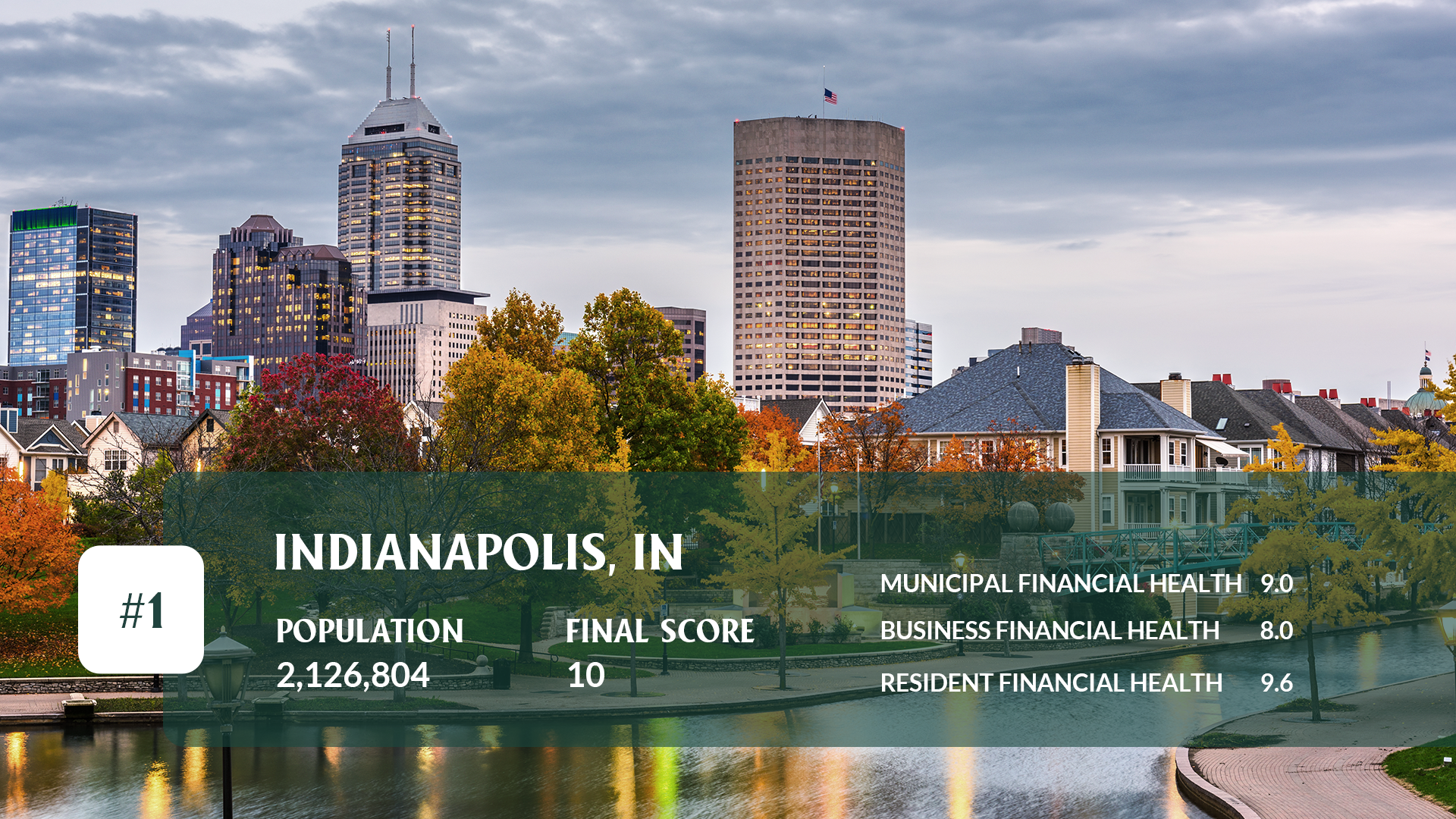
MSA Population: 2,216,804 MSA GDP per capita: $69,087 Municipal Financial Score: 8.96 Business Financial Score: 8.03 Resident Financial Score: 9.59
More than just a hub for fast cars, Indianapolis’ top-ten showing in all subcategories helped it race to our overall financially healthiest city. But its #2 position in residential health points to its biggest strength — that Hoosier financial health has successfully served Hoosiers most of all. Residents in Indianapolis benefit from low average debt-to-income ratios, and some of the most affordable homes in the country. They are enjoying more new home starts than the city has seen in 17 years. New homeowners can take multiple new public transport lines and bus service that’s set to expand 70%, taking advantage of the city’s expanded services in one of the country’s not only financially healthiest, but most balanced, city economies.
#2 Salt Lake City, UT
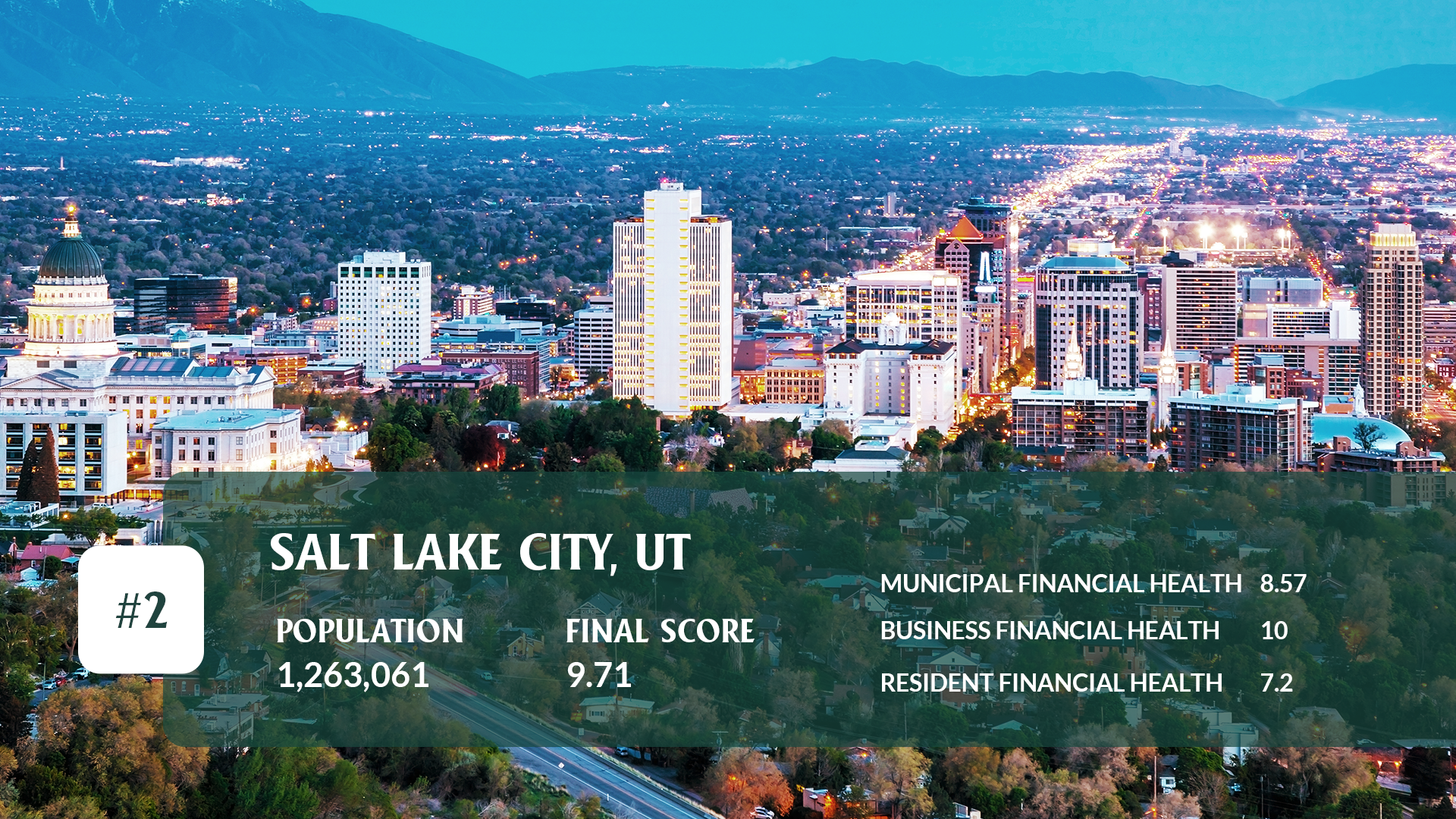
MSA Population: 1,263,061 MSA GDP per capita: $82,271 Municipal Financial Score: 8.57 Business Financial Score: 10.00 Resident Financial Score: 9.71
With the state’s flat 4.85% corporate tax rate, business category winner Salt Lake City attracts new owners from all over the world. Most agree with the governor’s call to arms that a low-tax business climate returns more money to Utah residents, reduces inflationary pressure, and creates more opportunities to scale businesses on what’s been called the “Silicon Slopes.” Utah, which has grown more than any other state over the last decade, is finding out that as its market sprawls into the nearby Wasatch range, the city’s biggest challenge will become maintaining its high level of opportunity for all who settle here.
#3 Atlanta-Sandy Springs-Alpharetta, GA

MSA Population: 6,144,050 MSA GDP per capita: $69,245 Municipal Financial Score: 10.00 Business Financial Score: 7.57 Resident Financial Score: 8.03
It’s no surprise that Hotlanta is on fire. It’s been named the top city for business climate for 7 straight years, and in our study, it brings home the** #1 spot for municipal financial health**, with a robust rainy day fund and healthy state balance sheet. The city has funds on hand should it need to operate through a downturn, but it may not need them. After all, residents are starting new businesses here at the 2nd highest rate in the country, and few existing companies are leaving the area. As a transportation and logistics center for the Southeast, perhaps it makes sense that the remote revolution hasn’t dampened Atlanta’s financial growth.
#4 Austin-Round Rock-Georgetown, TX
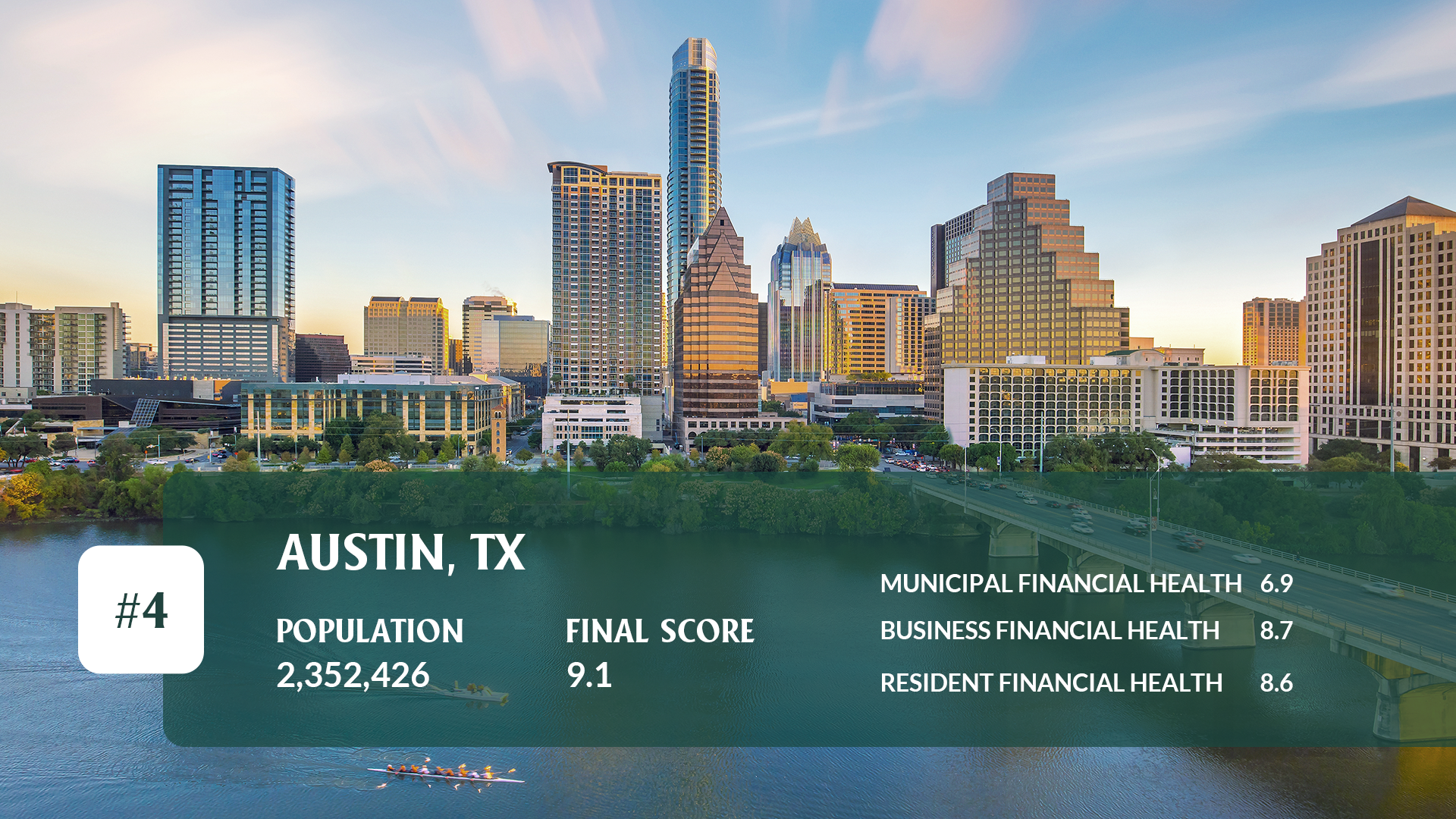
MSA Population: 2,352,426 MSA GDP per capita: $71,601 Municipal Financial Score: 6.87 Business Financial Score: 8.74 Resident Financial Score: 8.58
Nestled in the rolling Texas Hill Country, Austin just might be the winner of the pandemic’s great relocation. The prize? The city has seen 46,676 residential units permitted over the past 12 months, highlighting a booming construction industry, a labor crunch, shortages of materials, and the realization that the city is going to have to loosen its belt to make room for the 4 million people expected to move in by 2040. And all those newcomers are ready to contribute to the city’s financial health. Austin’s job creation score is #2 (behind Jacksonville, FL), as is its business creation score (behind Riverside, CA). As companies keep looking to Austin for a home base, housing starts will remain on hyperdrive.
#5 Charlotte-Concord-Gastonia, NC-SC
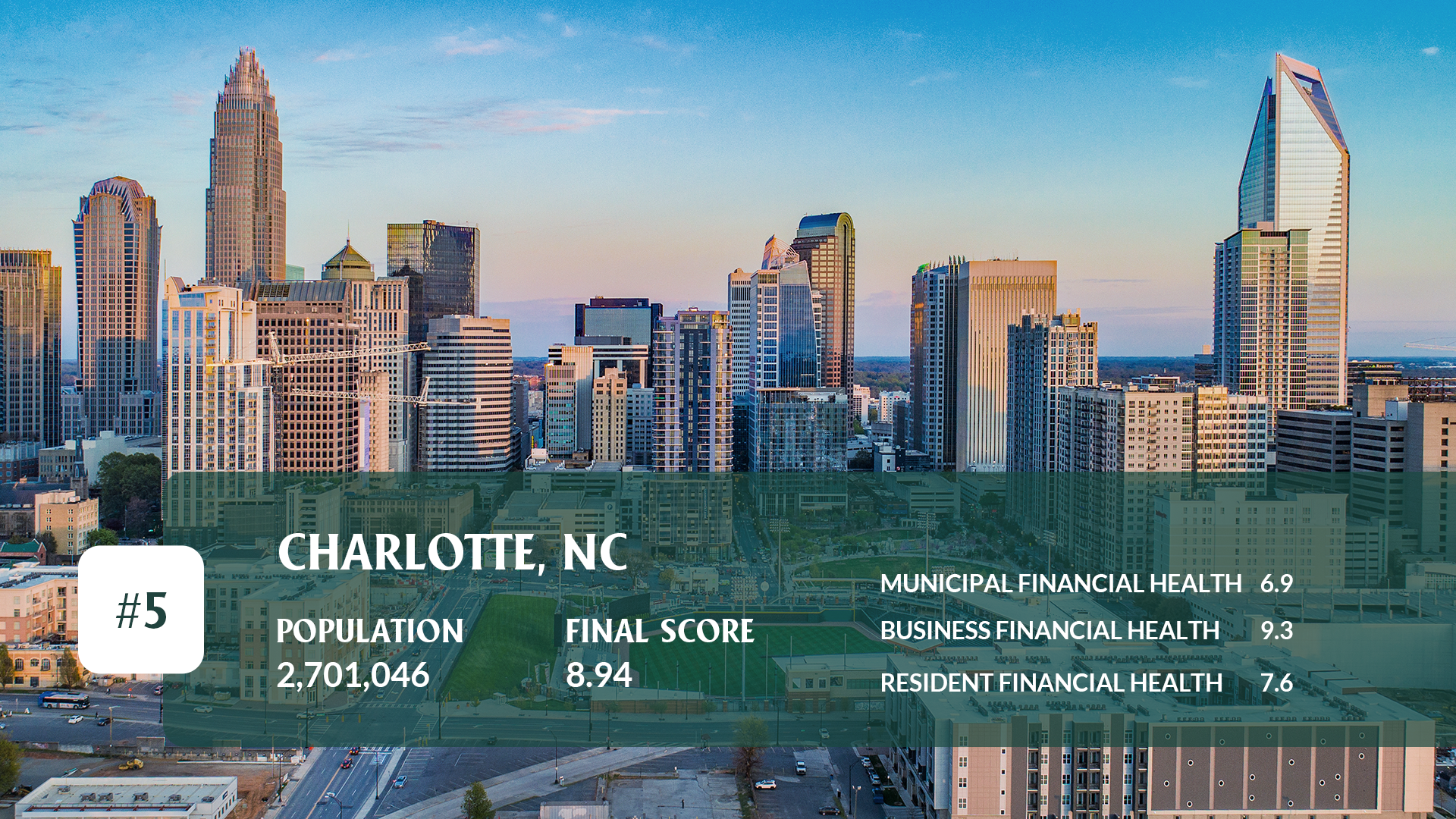
MSA Population: 2,701,046 MSA GDP per capita: $68,425 Municipal Financial Score: 6.88 Business Financial Score: 9.29 Resident Financial Score: 7.59
Long a banking outpost, the Queen City is becoming a financial maven, climbing to our 5th spot for business financial health via North Carolina’s top ranking for business tax climate. In late 2021, the state passed a budget adding to its rainy day fund and eliminating corporate taxes, setting the stage for a 0% tax rate by 2030. Lower bills have cleared the way for new business applications and for more companies to relocate to the Tarheel state and put down roots. They have. Across North Carolina, business starts broke records in 2021, with 40% more applications than the year before.
#6 Raleigh-Cary, NC
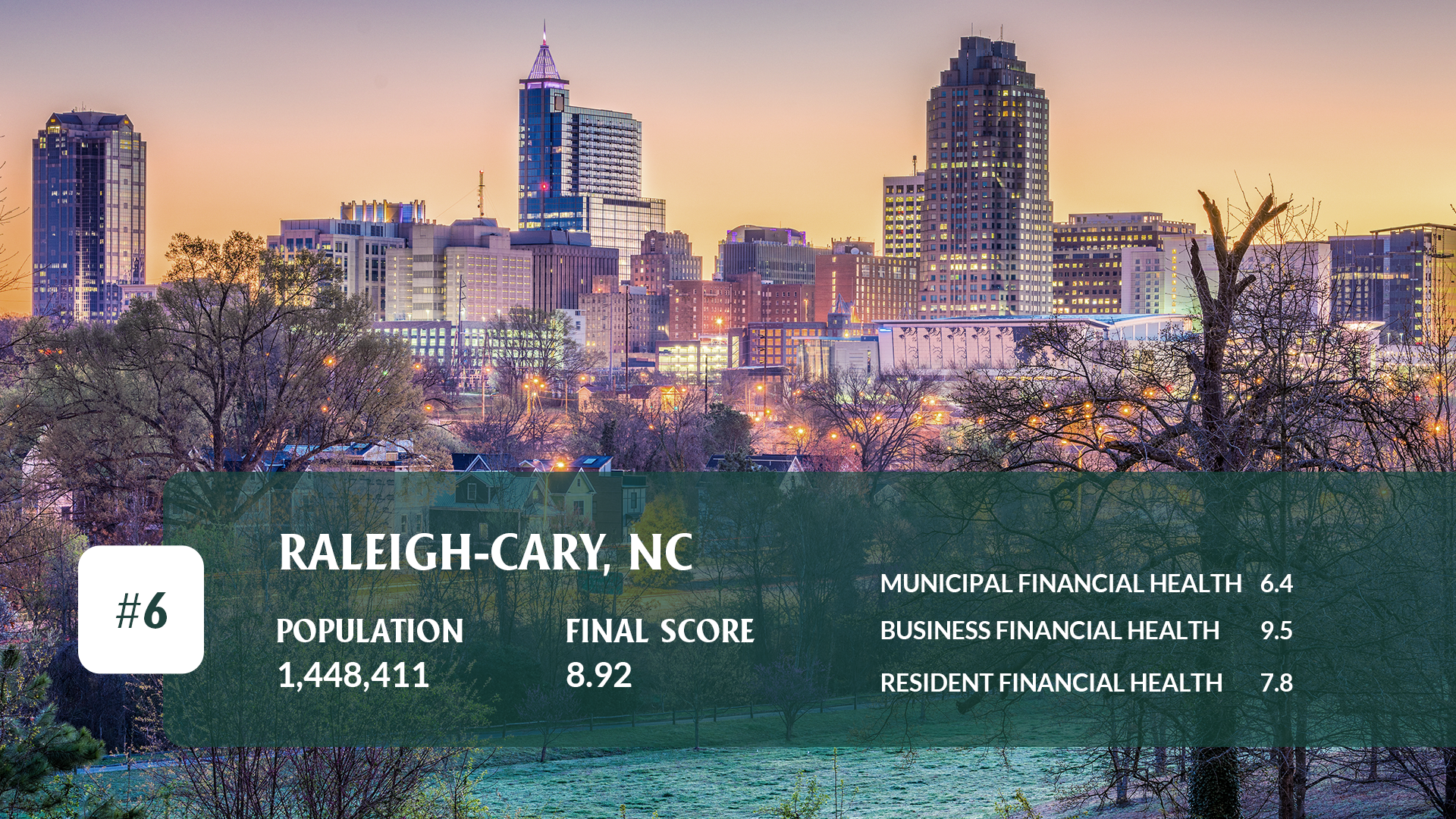
MSA Population: 1,448,411 MSA GDP per capita: $65,813 Municipal Financial Score: 6.44 Business Financial Score: 9.45 Resident Financial Score: 7.82
Raleigh’s high business financial health score is the secret sauce that fuels its overall ranking. It even scores higher than its southern sister, Charlotte, in business health, with fewer bankrupcies though it starts, attracts, and retains similar new businesses and jobs. Located in the “Research Triangle” where Duke, North Carolina State University, and the University of North Carolina Chapel Hill meet, it might be an educated local talent pipeline that supports new business success here. It may also be the low cost of living, which helps new businesses afford top talent. Whatever the reason, tech giants like Apple and Google recently announced new offices in Raleigh, helping cement the city’s place as a destination for smart companies looking to thrive in the future.
#7 Houston-The Woodlands-Sugar Land, TX
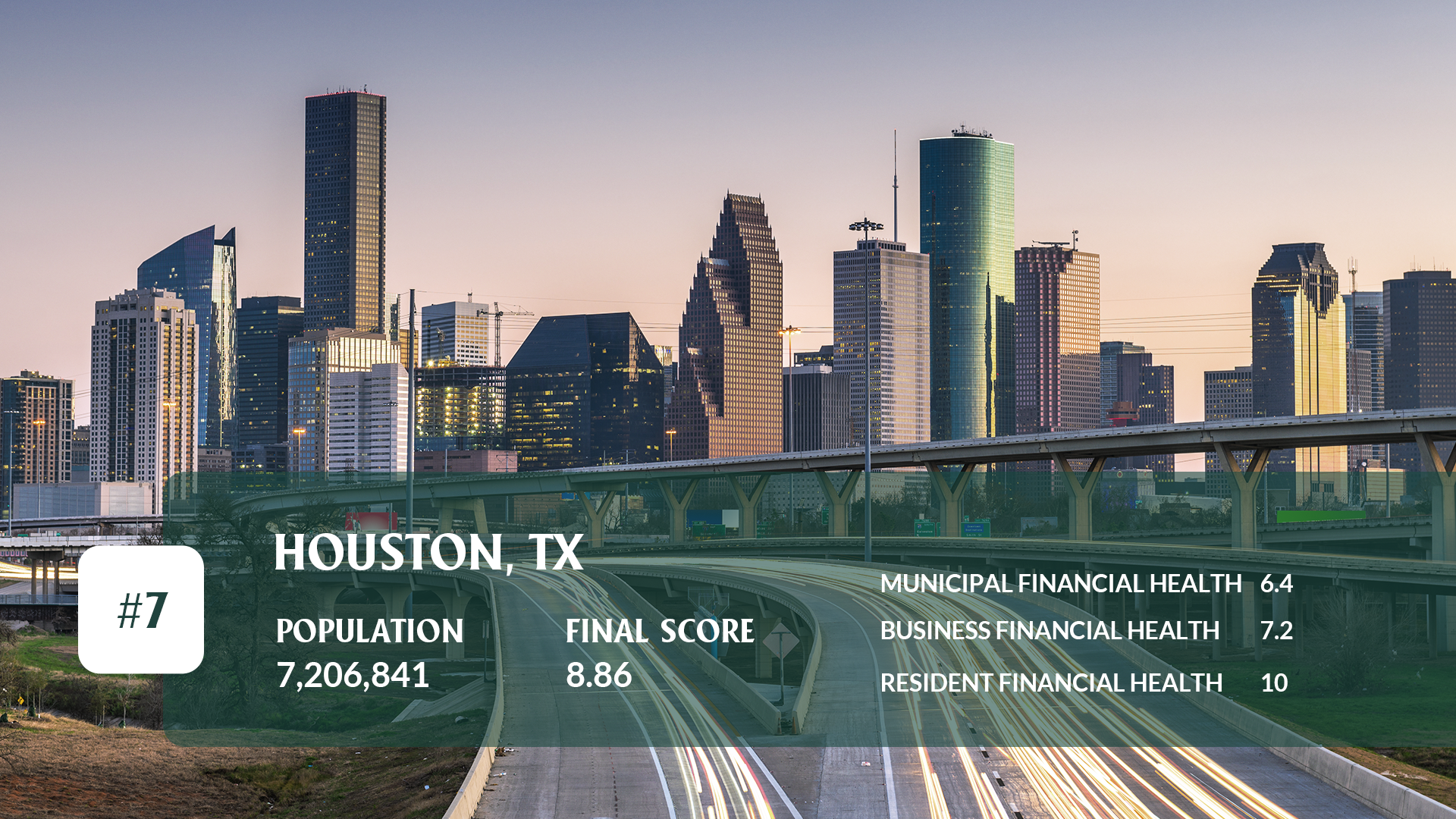
MSA Population: 7,206,841 MSA GDP per capita: $67,736 Municipal Financial Score: 6.36 Business Financial Score: 7.20 Resident Financial Score: 10.00
This bayside behemoth on the Gulf of Mexico is the country’s 4th largest metropolitan area, but it was once just a rural port supporting inland agriculture and ranching. With the discovery of oil, Houston began its meteoric rise, bringing universities, an educated labor force, synthetic petrochemical manufacturing, and high-tech industries. By the 1960s, NASA even selected the site as its operations hub. The city’s combination of low residential debt to income scores and sky-high home building support Houstonians today as they venture into the final frontier.
#8 Minneapolis-St. Paul-Bloomington, MN-WI
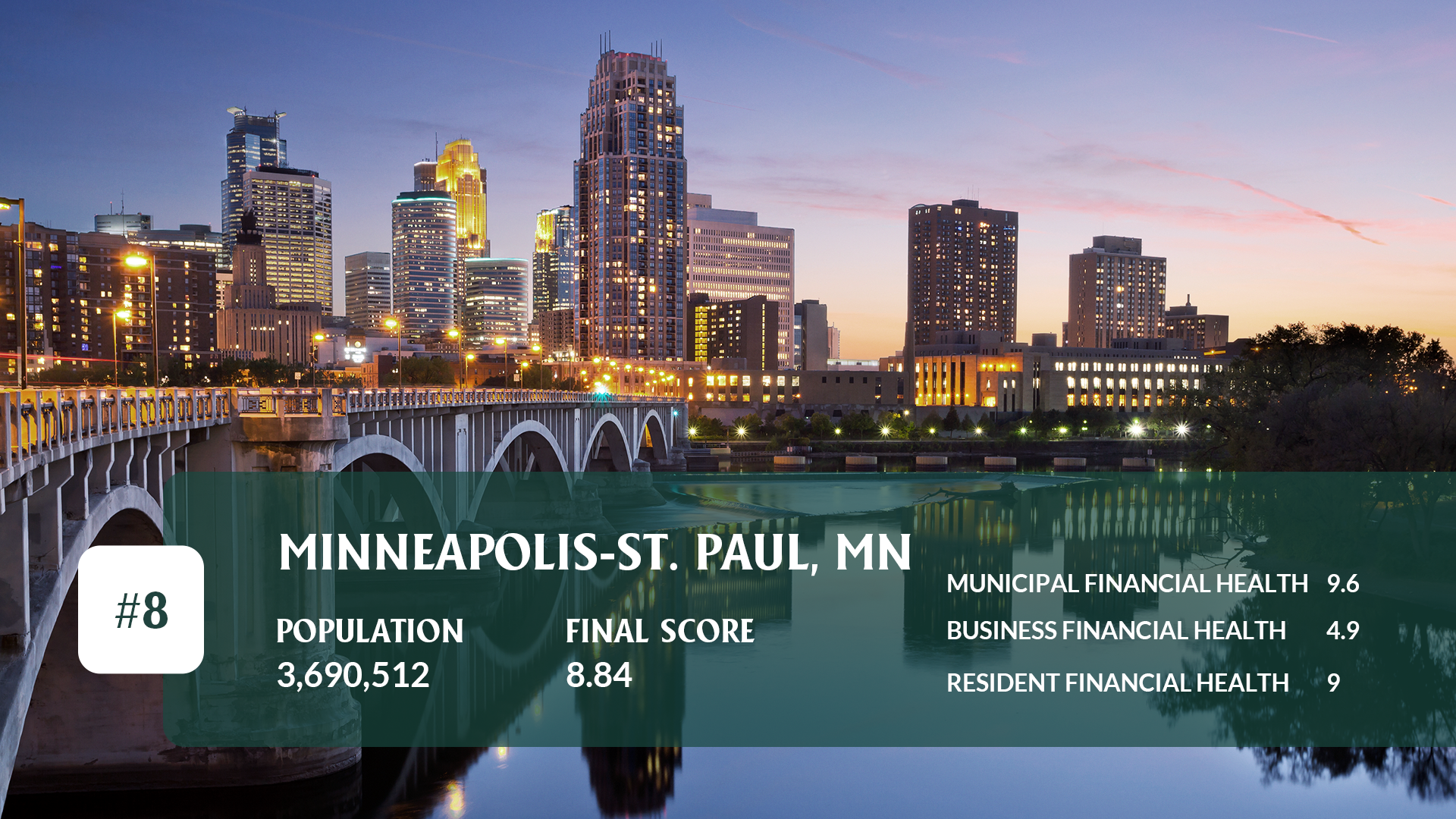
MSA Population: 3,690,512 MSA GDP per capita: $73,237 Municipal Financial Score: 9.62 Business Financial Score: 4.89 Resident Financial Score: 8.99
With plenty of municipal savings (coming in #2 for rainy day funds), Minneapolis can hibernate through its famous blizzards without compromising residents’ quality of life. And that’s good news because residents here share financial prosperity with their city. GDP per capita (#2) and housing affordability (#18, overall, and second to Indianapolis among the top ten cities) are high. And against the odds, Minneapolis is slowly picking up population, with an uptick in new housing permits, more than in the past 16 years. While other cold, high-income tax, urban areas are losing in the post-pandemic reshuffle, Minneapolis is holding its own. It is one of the most financially healthy cities in the country.
#9 Dallas-Fort Worth-Arlington, TX
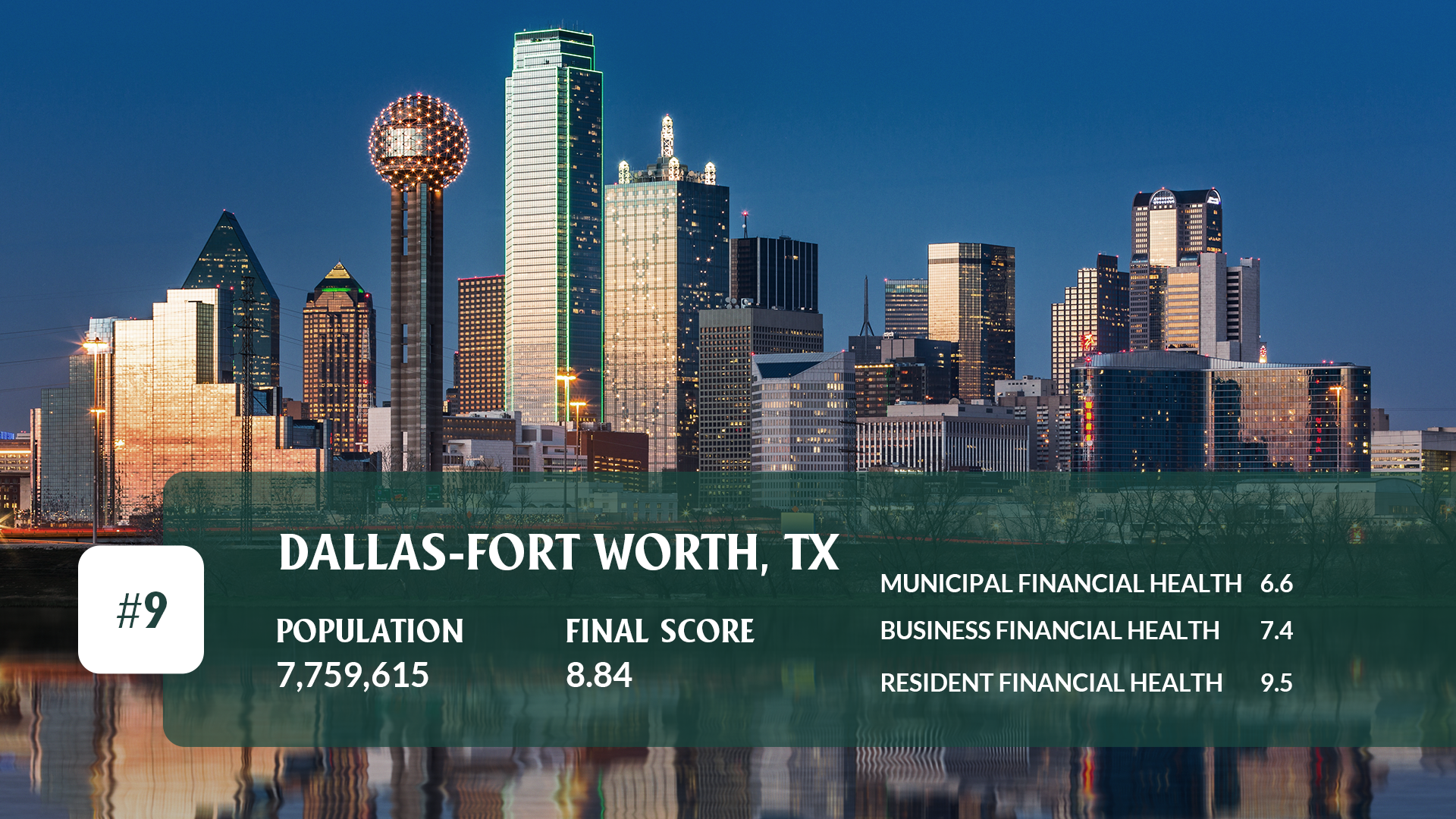
MSA Population: 7,759,615 MSA GDP per capita: $68,922 Municipal Financial Score: 6.58 Business Financial Score: 7.43 Resident Financial Score: 9.49
“Everything is bigger in Texas” holds true for #9 Dallas. The city is known for its sky-high hair, the country’s most valuable football franchise, and the nation’s largest arts district. It adds up to a desirable city that’s #9 in new home construction and is keeping more cash in residents’ pockets (to spend on those 50-yard-line tickets?) with the country’s 3rd lowest debt-to-income ratio at 1.08. Dallas is also 3rd for overall resident financial health, just behind Houston and Indianapolis. And while Dallas doesn’t make the top ten for business financial health due to high bankruptcies, the business tax climate, new business applications, business creation, and job creation all show that entrepreneurs have a bigger chance of success in the Big D.
#10 San Jose-Sunnyvale-Santa Clara, CA
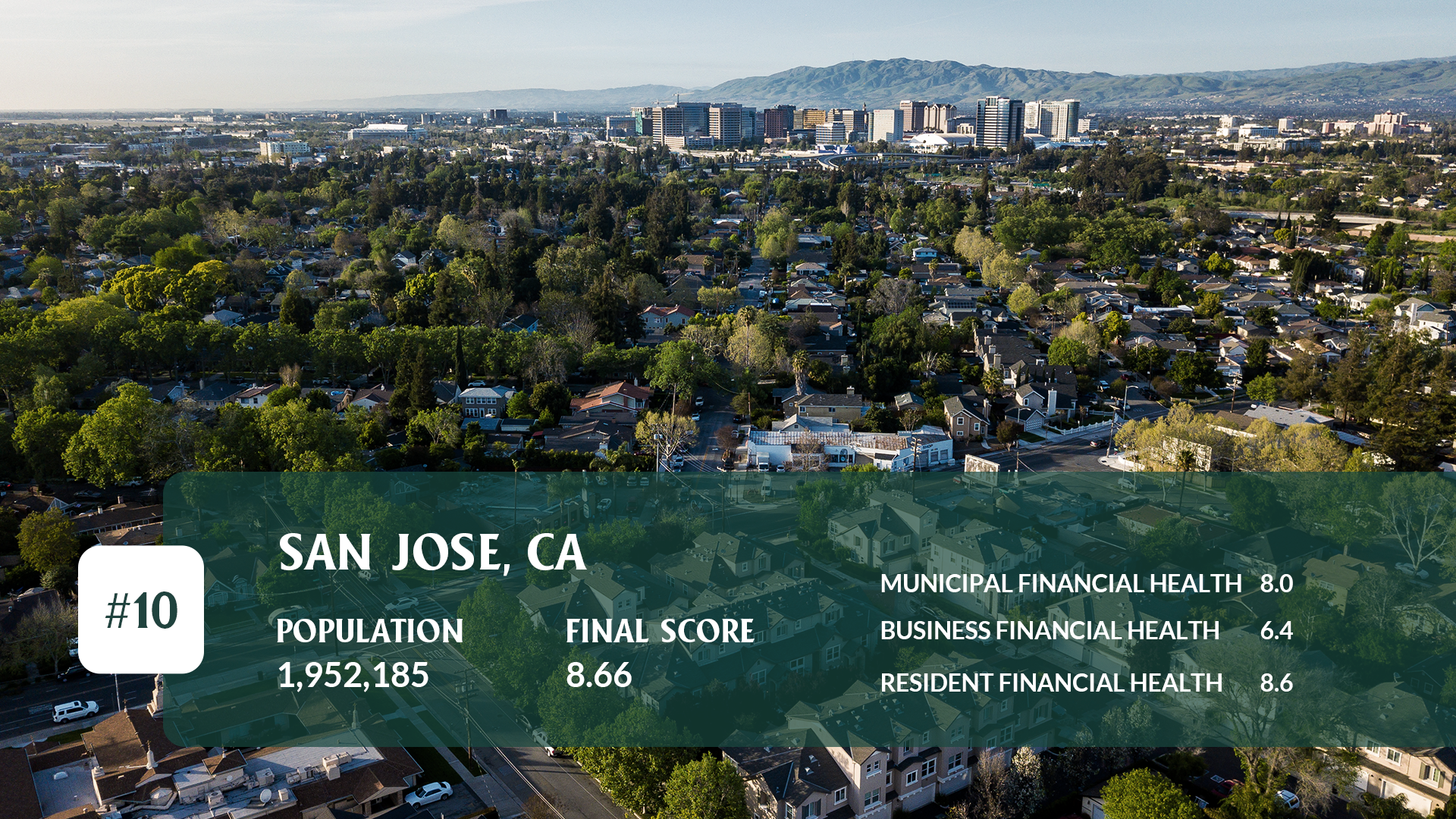
MSA Population: 1,952,185 MSA GDP per capita: $184,671 Municipal Financial Score: 8.04 Business Financial Score: 6.37 Resident Financial Score: 8.61
Residents of the shockingly pricy Santa Clara Valley are out-earning everyone else in the country. But their spending power can’t keep pace. With high costs and high regulation, businesses in 2021 exited California at double the rate of 2019 to 2020, by some counts approximately 352 companies of over 100 employees have left the state since 2020. In what was once the most significant incubator of highly-educated tech talent, this fading startup capital scored only 20th of our total 55 cities for new business creation. And when it comes to business applications per capita, the city ranked 49th. While San Jose is still the 7th biggest generator of new jobs, it’s a little harder today to see the gold in the once Golden State.
Conclusion
They say that you have nothing without your health. It might be the same for cities without their financial health. Without stable revenues, they can’t provide the infrastructure for residents to connect to the internet, source educated talent, and hobnob with investors to jumpstart the next unicorn. And that means that the city never realizes pie-in-the-sky tax revenues from successful businesses (and their owners), and struggles to provide new services to ignite future growth.
It’s a system, and some cities in our ranking did well on just a part of the whole, for example, excelling in business financial health. Until they put together the complete machine, empowering their residents, cities, and businesses, their financial health is still a work in progress. But those cities that reign in costs, empower their residents, and save for a rainy day will find they have the right tools for a resilient financial future.
Methodology
To find the most financially healthy metros in America we compared the 55 U.S. Metropolitan Statistical Areas with over 1 million residents across 3 key categories and a total of 12 individual factors:
Metropolitan Statistical Area population (2021 Estimates). Census
Municipal Finanical Health
- MSA GDP per capita (2020). Bureau of Economic Analysis
- Number of days each state could run on rainy day funds (2022 estimates). Pew Trusts
- State Financial Balance: a ratio of state revenue to state debt (2020). Urban Institute
Business Financial Health
- New Business Creation Score: a ratio of new business establishments to number of business establishment exits (2020). Census
- Number of Business Applications, per capita (2021). Census
- Job creation rate (2020). Census
- Total count of business bankruptcies (during 12-month period ending September 2022). U.S. Courts
- State business tax climate ranking (2023)._ Tax Foundation_
Resident Financial Health
- Household income (2021). Census
- Home Affordability: a ratio of home value to household income. Zillow, Census
- Total residential units authorized per capita (during 12-month period ending September 2022). U.S. Department of Housing and Urban Development
- Household debt to income ratio. Federal Reserve
We scored each factor with an equal-weighted score (where 10 is the highest score). We then averaged the factor scores within each of the three categories listed above to find each individual category score. Then, we normalized the category score so that the highest-scoring MSA within each category received a high score of 10 (the highest score).
The final score was calculated by averaging the score of the 3 categories, then normalized to produce the final score and ranking.
Frequently Asked Questions
What is the Financial Health Index?
The Financial Health Index measures the economic stability of cities across the U.S. by evaluating factors like income levels, employment rates, and financial services accessibility.
How do you determine if a city is flourishing economically?
A city is considered flourishing if it has high income levels, robust employment rates, and effective financial management among residents and local businesses.
Which U.S. cities top the Financial Health Index?
While the specific cities vary each year, typically those with strong tech sectors, diversified economies, and effective governance rank high.
What factors contribute to a city's high ranking on the Index?
Key contributors include a thriving job market, high median incomes, low unemployment rates, and strong financial literacy programs.
How can this index help individuals and businesses?
The index provides insights into economic conditions, helping individuals decide where to live and businesses where to invest or expand.
Edited by:
Bryan Huynh
•
Product Tester & Writer

























































































